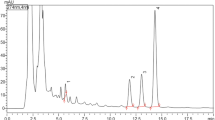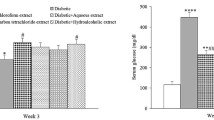Abstract
Cinnamon (Cinnamomum zeylanicum), fenugreek (Trigonella foenum-graecum), shallot (Allium hirtifolium Boiss), and clove (Syzygium aromaticum) are well-known and widely used medicinal plants in the world. There is some experimentally proven evidence demonstrated the beneficial effects of these herbs on metabolic disorders like diabetes. Despite the fact that there are limited studies in the field of herb-herb interactions, some of the diabetic patients prefer to use these herbs in a combination form. The aim of this study was to evaluate the possible effects of an equal mixture of these plants (named Tetraherbs) in streptozotocin (STZ)-induced diabetic rats. Severe diabetic rats (FBS above 350 mg/dL) were treated orally with ethanolic extracts of cinnamon (EEC), fenugreek (EEF), shallot (EES), and clove (EECL) separately at the dose of 75 mg/kg, or in equal combination formula (Tetraherbs) at doses of 100–300 mg/kg once per day for 28 days. At the end of the study, their effects on glucose levels, plasma lipids, liver enzymes activity, and histology of pancreas were evaluated. The blood glucose lowering activity, as well as pancreatic β cell regeneration of Tetraherbs, was significantly higher than the plants when they used separately. However, there was no significant difference in lipid-lowering and hepatoprotective potentials of the herbs whether used singly or in combination. In conclusion, the results of the present study provide evidence show combination form of the studied plants increased their glucose-lowering activity by positive interaction.


Similar content being viewed by others
References
Abtahi-Evari S-H, Shokoohi M, Abbasi A et al (2017) Protective effect of Galega officinalis extract on Streptozotocin-induced kidney damage and biochemical factor in diabetic rats. Crescent J Med Biol Sci 4:108–114
Adefegha SA, Oboh G (2012) In vitro inhibition activity of polyphenol-rich extracts from Syzygium aromaticum (L.) Merr. & Perry (Clove) buds against carbohydrate hydrolyzing enzymes linked to type 2 diabetes and Fe(2+)-induced lipid peroxidation in rat pancreas. Asian Pac J Trop Biomed 2:774–781. https://doi.org/10.1016/S2221-1691(12)60228-7
Akilen R, Tsiami A, Devendra D, Robinson N (2012) Cinnamon in glycaemic control: systematic review and meta analysis. Clin Nutr 31:609–615. https://doi.org/10.1016/j.clnu.2012.04.003
Cheng DM, Kuhn P, Poulev A, Rojo LE, Lila MA, Raskin I (2012) In vivo and in vitro antidiabetic effects of aqueous cinnamon extract and cinnamon polyphenol-enhanced food matrix. Food Chem 135:2994–3002. https://doi.org/10.1016/j.foodchem.2012.06.117
Cole L, Kramer P (2016) Human physiology, biochemistry and basic medicine - chapter 2.2. Academic Press
Dabaghian FH, Kamalinejad M, Shojaei A, Abdollahi Fard M (2012) Presenting anti-diabetic plants in Iranian traditional medicine. J Diabetes Endocrinol 3:70–76. https://doi.org/10.5897/JDE12.004
Davidson EP, Coppey LJ, Holmes A, Dake B, Yorek MA (2011) Effect of treatment of high fat fed / low dose streptozotocin-diabetic rats with Ilepatril on vascular and neural complications. Eur J Pharmacol 668:497–506. https://doi.org/10.1016/j.ejphar.2011.07.016
Deng R (2012) A review of the hypoglycemic effects of five commonly used herbal food supplements. Recent Pat Food Nutr Agric 4:50–60. https://doi.org/10.2174/2212798411204010050
Ekor M, Pistelli L (2013) Frontiers The growing use of herbal medicines issues relating to adverse reactions and challenges in monitoring safety. Pharmacology Front Pharmacol v.4:177. doi:10.3389%2Ffphar.2013.00177
Fard MH, Naseh G, Lotfi N et al (2015) Effects of aqueous extract of turnip leaf (Brassica rapa) in alloxan-induced diabetic rats. Avicenna J Phytomedicine 5:148–156
Farrokhfall K, Khoshbaten A, Zahediasl S, Mehrani H, Karbalaei N (2014) Improved islet function is associated with anti-inflammatory, antioxidant and hypoglycemic potential of cinnamaldehyde on metabolic syndrome induced by high tail fat in rats. J Funct Foods 10:397–406. https://doi.org/10.1016/j.jff.2014.07.014
Ghiravani Z, Hosseini M, Taheri MMH, Fard MH, Abedini MR (2016) Evaluation of hypoglycemic and hypolipidemic effects of internal septum of walnut fruit in alloxan-induced diabetic rats. African J Tradit Complement Altern Med 13:94–100. https://doi.org/10.4314/ajtcam.v13i2.12
Gillies CL, Abrams KR, Lambert PC, Cooper NJ, Sutton AJ, Hsu RT, Khunti K (2007) Pharmacological and lifestyle interventions to prevent or delay type 2 diabetes in people with impaired glucose tolerance: systematic review and meta-analysis. Bmj 334:299–299. https://doi.org/10.1136/bmj.39063.689375.55
Gu J, Zhang X, Ma Y, Li N, Luo F, Cao L, Wang Z, Yuan G, Chen L, Xiao W, Xu X (2015) Quantitative modeling of dose–response and drug combination based on pathway network. J Cheminform 7:19. https://doi.org/10.1186/s13321-015-0066-6
Hami J, Vafaei-nezhad S, Ghaemi K, Sadeghi A, Ivar G, Shojae F, Hosseini M (2016) Stereological study of the effects of maternal diabetes on cerebellar cortex development in rat. Metab Brain Dis 31:643–652. https://doi.org/10.1007/s11011-016-9802-5
Hassanzadeh-Taheri M, Hassanpour-Fard M, Doostabadi M, Moodi H, Vazifeshenas-Darmiyan K, Hosseini M (2018a) Co-administration effects of aqueous extract of turnip leaf and metformin in diabetic rats. J Tradit Complement Med 8:178–183. https://doi.org/10.1016/j.jtcme.2017.05.010
Hassanzadeh-Taheri M, Hosseini M, Hassanpour-Fard M, Ghiravani Z, Vazifeshenas-Darmiyan K, Yousefi S, Ezi S (2016) Effect of turnip leaf and root extracts on renal function in diabetic rats. Orient Pharm Exp Med 16:279–286. https://doi.org/10.1007/s13596-016-0249-3
Hassanzadeh-Taheri, Mohammadmehdi, Hosseini M, et al (2018b) Acute and sub-acute oral toxicity evaluation of Astragalus hamosus seedpod ethanolic extract in Wistar rats. 24:23–30. doi: https://doi.org/10.15171/PS.2018.05
Hassanzadeh- Taheri M, Hassanzadeh- Taheri M, Jahani F, Hosseini M (2018) Effects of yoghurt butter oils on rat plasma lipids, haematology and liver histology parameters in a 150-day study. Int J Dairy Technol 71:140–148
Hosni AA, Abdel-Moneim AA, Abdel-Reheim ES, Mohamed SM, Helmy H (2017) Cinnamaldehyde potentially attenuates gestational hyperglycemia in rats through modulation of PPARγ, proinflammatory cytokines and oxidative stress. Biomed Pharmacother 88:52–60
Hule AK, Shah AS, Gambhire MN, Juvekar AR (2011) An evaluation of the antidiabetic effects of Elaeocarpus ganitrus in experimental animals. Indian J Pharm 43:56–59. https://doi.org/10.4103/0253-7613.75671
Jalal R, Bagheri SM, Moghimi A, Rasuli MB (2007) Hypoglycemic effect of aqueous shallot and garlic extracts in rats with fructose-induced insulin resistance. J Clin Biochem Nutr 41:218–223. https://doi.org/10.3164/jcbn.2007031
Jeong KJ, Kim DY, Quan HY, Jo HK, Kim GW, Chung SH (2014) Effects of eugenol on hepatic glucose production and AMPK signaling pathway in hepatocytes and C57BL/6J mice. Fitoterapia 93:150–162. https://doi.org/10.1016/j.fitote.2013.12.023
Joshi DV, Patil RR, Naik SR (2015) Hydroalcohol extract of Trigonella foenum-graecum seed attenuates markers of inflammation and oxidative stress while improving exocrine function in diabetic rats. Pharm Biol 53:201–211. https://doi.org/10.3109/13880209.2014.913296
Kalia A, Gauttam V (2013) Development of polyherbal antidiabetic formulation encapsulated in the phospholipids vesicle system. J Adv Pharm Technol Res 4:108–117. https://doi.org/10.4103/2231-4040.111527
Katiyar D, Singh V, Gilani SJ, Goel R, Grover P, Vats A (2015) Hypoglycemic herbs and their polyherbal formulations: a comprehensive review. Med Chem Res 24:1–21. https://doi.org/10.1007/s00044-014-1080-3
Kokil GR, Veedu RN, Ramm GA, Prins JB, Parekh HS (2015) Type 2 diabetes mellitus: limitations of conventional therapies and intervention with nucleic acid-based therapeutics. Chem Rev 115:4719–4743. https://doi.org/10.1021/cr5002832
Kubec R, Dadakova E (2009) Chromatographic methods for determination of S-substituted cysteine derivatives—a comparative study. J Chromatogr A 1216:6957–6963. https://doi.org/10.1016/j.chroma.2009.08.032
Kuroda M, Mimaki Y, Ohtomo T, Yamada J, Nishiyama T, Mae T, Kishida H, Kawada T (2012) Hypoglycemic effects of clove (Syzygium aromaticum flower buds) on genetically diabetic KK-A y mice and identification of the active ingredients. J Nat Med 66:394–399. https://doi.org/10.1007/s11418-011-0593-z
Li R, Liang T, Xu L, Li Y, Zhang S, Duan X (2013) Protective effect of cinnamon polyphenols against STZ-diabetic mice fed high-sugar, high-fat diet and its underlying mechanism. Food Chem Toxicol 51:419–425. https://doi.org/10.1016/j.fct.2012.10.024
Lotfi N, Hami J, Hosseini M, Haghir D, Haghir H (2016) Diabetes during pregnancy enhanced neuronal death in the hippocampus of rat offspring. Int J Devl Neurosci Int J Dev Neurosci 51:28–35. https://doi.org/10.1016/j.ijdevneu.2016.04.009
Lu T, Sheng H, Wu J, Cheng Y, Zhu J, Chen Y (2012) Cinnamon extract improves fasting blood glucose and glycosylated hemoglobin level in Chinese patients with type 2 diabetes. Nutr Res 32:408–412. https://doi.org/10.1016/j.nutres.2012.05.003
Mahmoodi M, Hosseini J, Hosseini Zijoud S-M et al (2013a) The effect of Persian shallot (Allium hirtifolium Boiss.) extract on blood sugar and serum levels of some hormones in diabetic rats. Pak J Pharm Sci 26:397–402
Mahmoodi M, Zarei S, Rezaeian M, Arababadi MK, Ghasemi H, Khoramdelazad H, Rezayati N, Hasanshahi G, Hosseini-Zijoud SM (2013b) Persian shallot (Allium hirtifolium Boiss) extract elevates glucokinase (GCK) activity and gene expression in diabetic rats. Am J Plant Sci 4:1393–1399
Mbarki S, Alimi H, Bouzenna H, Elfeki A, Hfaiedh N (2017) ScienceDirect phytochemical study and protective effect of Trigonella foenum graecum (Fenugreek seeds) against carbon tetrachloride-induced toxicity in liver and kidney of male rat. Biomed Pharmacother 88:19–26. https://doi.org/10.1016/j.biopha.2016.12.078
Medagama A, Bandara R (2014) The use of Complementary and Alternative Medicines (CAMs) in the treatment of diabetes mellitus: is continued use safe and effective? Nutr J 13:1–9. https://doi.org/10.1186/1475-2891-13-102
Mythili MD, Vyas R, Akila G, Gunasekaran S (2004) Effect of streptozotocin on the ultrastructure of rat pancreatic islets. Microsc Res Tech 63:274–281. https://doi.org/10.1002/jemt.20039
Ogurtsova K, da Rocha Fernandes JD, Huang Y, Linnenkamp U, Guariguata L, Cho NH, Cavan D, Shaw JE, Makaroff LE (2017) IDF Diabetes Atlas: global estimates for the prevalence of diabetes for 2015 and 2040. Diabetes Res Clin Pract 128:40–50. https://doi.org/10.1016/j.diabres.2017.03.024
Pandey A, Tripathi P, Pandey R et al (2004) Alternative therapies useful in the management of diabetes: a systematic review. Altern Ther Health Med 10:44–50. https://doi.org/10.4103/0975-7406.90103
Ping H, Zhang G, Ren G (2010) Antidiabetic effects of cinnamon oil in diabetic KK-Ay mice. Food Chem Toxicol 48:2344–2349. https://doi.org/10.1016/j.fct.2010.05.069
Prasad RC, Herzog B, Boone B, Sims L, Waltner-Law M (2005) An extract of Syzygium aromaticum represses genes encoding hepatic gluconeogenic enzymes. J Ethnopharmacol 96:295–301. https://doi.org/10.1016/j.jep.2004.09.024
Raju J, Gupta D, Rao AR, Yadava PK, Baquer NZ (2001) Trigonella foenum graecum (fenugreek) seed powder improves glucose homeostasis in alloxan diabetic rat tissues by reversing the altered glycolytic, gluconeogenic and lipogenic enzymes. Mol Cell Biochem 224:45–51. https://doi.org/10.1023/A:1011974630828
Sadati SN, Ardekani MRS, Ebadi N, Yakhchali M, Dana AR, Masoomi F, Khanavi M, Ramezany F (2016) Review of scientific evidence of medicinal convoy plants in traditional Persian medicine. Pharmacogn Rev 10:33–38. https://doi.org/10.4103/0973-7847.176546
Shukla S, Chatterji S, Mehta S, Rai PK, Singh RK, Yadav DK, Watal G (2011) Antidiabetic effect of Raphanus sativus root juice. Pharm Biol 49:32–37. https://doi.org/10.3109/13880209.2010.493178
Srinivasan S, Muthukumaran J, Muruganathan U, Venkatesan RS, Jalaludeen AM (2014) Antihyperglycemic effect of syringic acid on attenuating the key enzymes of carbohydrate metabolism in experimental diabetic rats. Biomed Prev Nutr 4:595–602. https://doi.org/10.1016/j.bionut.2014.07.010
Sushma N, Devasena T (2010) Aqueous extract of Trigonella foenum graecum (fenugreek) prevents cypermethrin-induced hepatotoxicity and nephrotoxicity. Hum Exp Toxicol 29:311–319. https://doi.org/10.1177/0960327110361502
Tu Z, Moss-Pierce T, Ford P, Jiang TA (2014) Syzygium aromaticum L. (Clove) extract regulates energy metabolism in myocytes. J Med Food 17:1003–1010. https://doi.org/10.1089/jmf.2013.0175
Vafaei-Nezhad S, Hami J, Sadeghi A, Ghaemi K, Hosseini M, Abedini MR, Haghir H (2016) The impacts of diabetes in pregnancy on hippocampal synaptogenesis in rat neonates. Neuroscience 318:122–133. https://doi.org/10.1016/j.neuroscience.2016.01.025
Waisundara VY, Hsu A, Tan BKH, Huang D (2009) Baicalin reduces mitochondrial damage in streptozotocin-induced diabetic Wistar rats. Diabetes Metab Res Rev 25:671–677. https://doi.org/10.1002/dmrr.1005
Yadav D, Aa C, Garg V et al (2015) In vitro toxicity and antidiabetic activity of a newly developed polyherbal formulation ( MACST/001 ) in streptozotocininduced diabetic Wistar rats. PubMed Commons Protoplasma 250:6–7. https://doi.org/10.1007/s00709
Zarezadeh M, Vazifeshenas- Darmiyan K, Afshar M et al (2017) Effects of extract of Crocus sativus petal on renal function in diabetic rats. J Maz Univ Med Sci 27:11–24
Zarvandi M, Rakhshandeh H, Abazari M, Shafiee-Nick R, Ghorbani A (2017) ScienceDirect safety and efficacy of a polyherbal formulation for the management of dyslipidemia and hyperglycemia in patients with advanced-stage of type-2 diabetes. Biomed Pharmacother 89:69–75. https://doi.org/10.1016/j.biopha.2017.02.016
Acknowledgements
This study was financially supported by Birjand University of Medical Sciences (Grant number: 1098). We would like to acknowledge the anonymous referees for helpful comments and suggestions.
Author information
Authors and Affiliations
Corresponding author
Ethics declarations
All the experiments involving animals were performed according to the guide line of the Institutional Animal Ethical Committee, Birjand University of Medical Sciences (the permit code is Ir.bums.REC.1394.373).
Conflict of interest
The authors declare that they have no conflict of interest.
Rights and permissions
About this article
Cite this article
Kiani, Z., Hassanpour-Fard, M., Asghari, Z. et al. Experimental evaluation of a polyherbal formulation (Tetraherbs): antidiabetic efficacy in rats. Comp Clin Pathol 27, 1437–1445 (2018). https://doi.org/10.1007/s00580-018-2755-9
Received:
Accepted:
Published:
Issue Date:
DOI: https://doi.org/10.1007/s00580-018-2755-9




